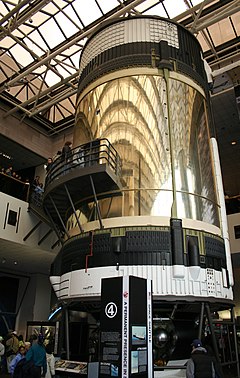Skylab B

Skylab B Orbital Workshop at the National Air and Space Museum
|
|
| Station statistics | |
|---|---|
| Call sign | Skylab B, International Skylab, Advanced Skylab |
| Crew | 3 |
| Launch | canceled (currently at the National Air and Space Museum in Washington D.C) |
| Mass | 77,088 kg |
| Height | 58 feet 5 inches (17.81 m) |
| Diameter | 21 feet 8 inches (6.60 m) |
| Days occupied | planned 56 to 90 days |
Skylab B was a proposed second US space station similar to Skylab that was planned to be launched by NASA for different purposes, mostly involving the Apollo–Soyuz Test Project, but was canceled due to lack of funding. Two Skylab modules were built in 1970 by McDonnell Douglas for the Skylab program, originally the Apollo Applications Program. The first was launched in 1973 and the other put in storage, while NASA considered how to use the remaining assets from Apollo.
One considered option was to use Saturn V SA-515 to launch the backup Skylab station into orbit sometime between January 1975 and April 1976. That way, it could expand the Apollo-Soyuz mission by 56–90 days.
Further proposals were made for an International Skylab, launched using Saturn V SA-514. This station would be serviced by Apollo, Soyuz and latter by the space shuttle.
Some uses considered for the second Skylab module included putting it into a rotation mode where it could generate artificial gravity and a plan to celebrate the 1976 United States Bicentennial with the launch of two Soviet Soyuz missions to the back-up Skylab.
When the Apollo–Soyuz Test Project was created in 1972, NASA had also considered launching the back-up Skylab station during the ASTP mission in 1975, which would involve the Apollo spacecraft docking with the Soyuz spacecraft first, performing intended operations, then heading for the Skylab B, which during the ASTP discussion was originally called the International Skylab, for a 56–90 days extended mission.
...
Wikipedia
